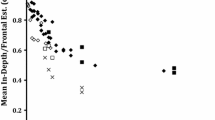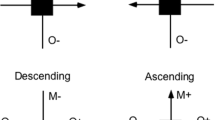Abstract
Subjects were required to make size discriminations comparing circular targets in horizontal and vertical planes of space. Comparisons were made in a totally darkened room void of any extrinsic cues for size or distance. Significant differences were noted when horizontal and vertical targets of equal size were compared. The horizontal target was estimated as much larger than the target in the vertical plane. Results were interpreted to indicate that head position was a critical variable in making size estimates under these experimental conditions. Subjects also were trained to compensate for the distortions in size induced by changing head position and were found to improve significantly in their size estimations. The results are further interpreted in the framework of a visual-vestibular interaction hypothesis.
Similar content being viewed by others
Reference Notes
THOR, D. H., & WOOD, R. J. 1966. Visual space perception and the moon illusion. Paper presented at the annual meeting of the American Psychological Association, New York.
PIGG, L. D., & KAMA, W. N. 1961. The effect of transient weightlessness on visual acuity. Wadc Technical Report, Wright Air Development Center, Wright-Patterson Air Force Base, Ohio.
BRAUNSTEIN, M. L., & WHITE, W. J. 1961. The effect of acceleration on visual brightness discrimination. Cornell Aeronautic Report Om-1570–6–1, Buffalo.
WOOD, R. J. 1968. The relationship between head position and brightness discrimination. Unpublished master’s thesis, Western Michigan University.
VAN EYL, F. P. 1968. The vestibular effect upon size-distanceperception. Paper presented at the meeting of the Michigan Academy of Arts, Science and Letters, Allendale.
References
BAKER, C. A. 1968. Visual capabilities in the space environment. London: Pergamon Press.
BILDERBACK, L. D., TAYLOR, R. E., & THOR, D. H. 1964. Distance perception in darkness, Science, 145, 294–295.
CHARNWOOD, L. 1950. The effect of posture on involuntary eye movements. Nature, 166, 348–349.
EPSTEIN, W. 1976. Varities of perceptual learning. New York: McGraw-Hill.
EPSTEIN, W., PARK, J., & CASEY, A. 1961. Current status of the size-distance invariance hypothesis. Psychological Bulletin, 58, 491–514.
GIBSON, E. J., BERGMAN, R., & PURDY, J. 1955. The effect of prior training with a scale of distance on absolute and relation judgments of distance over ground. Journal of Experimental Psychology, 50, 97–105.
GRUBER, H. E., KING, W. L., & LINK, S. 1963. The moon illusion: An event in imaginary space. Science, 139, 750–752.
HOLWAY, A. H., & BORING, E. G. 1940. The moon illusion and the angle of regard. American Journal of Psychology, 53, 109–116.
JUNG, R. 1961. Neuronal integration in the visual cortex and its significance for visual information. In Rosenblith (Ed.), Sensory communication. New York: John Wiley and Sons.
KAUFMAN, L., & ROCK, I. 1962. The moon illusion, I. Science, 136, 953–961.
ROCK, I., & KAUFMAN, L. 1962. The moon illusion, II. Science, 136, 1023–1031.
WOOD, R. J., ZINKUS, P. W., & MOUNTJOY, P. T. 1969. The vestibular hypothesis of the moon illusion. Psychomomic Science, 32, 109–110.
ZINKUS, P. W., & MOUNTJOY, P. T. 1970. The effect of head position on size discrimination. Psychonomie Science, 33, 35–36.
Author information
Authors and Affiliations
Rights and permissions
About this article
Cite this article
Zinkus, P.W., Mountjoy, P.T. The Effects of Information and Training on the Discrimination of Size in Different Planes of Space. Psychol Rec 28, 383–390 (1978). https://doi.org/10.1007/BF03394550
Published:
Issue Date:
DOI: https://doi.org/10.1007/BF03394550




